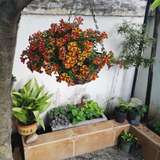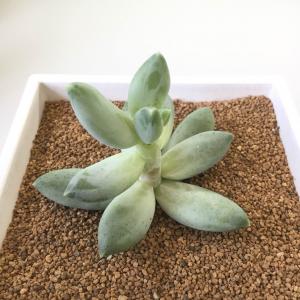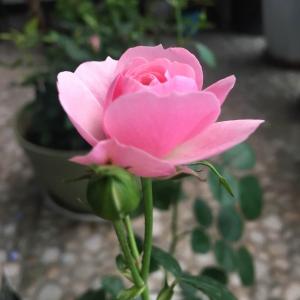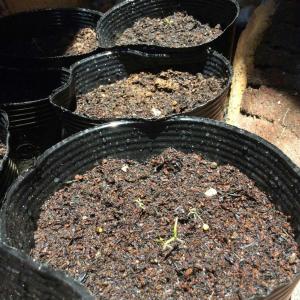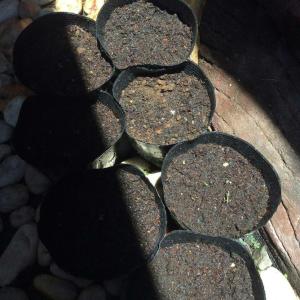文章
Miss Chen
2018年05月01日

铜钱草是多年生挺水或湿生草本植物,株高5~15厘米,小巧又玲珑,其沉水叶具长柄,圆盾形,缘波状,草绿色。铜钱草的花是伞形花序,小而白粉色。其茎节明显,一节一节的,每一节各长一枚叶,可一直延伸。铜钱草地下横走茎生长速度惊人,走到哪里就蔓延到哪里,而且对水质要求不严,可在硬度较低的淡水中进行栽培,是美观又易种的水生植物之一,具有极高的观赏价值。很多友友会问,铜钱草会开花吗?铜钱草是会开花的。铜钱草开花了怎么办?

铜钱草会开花吗?
铜钱草它会开花的,小花白粉色,其花期4月,同时它也会结果,果期7月,蒴果近球形。它性喜温暖潮湿,栽培处以半日照或遮阴处为佳,忌阳光直射,栽培土不拘,以松软排水良好的栽培土为佳,铜钱草最适水温22~28度。耐阴、耐湿,稍耐旱,适应性强。
铜钱草开花怎么办?
不少花友都觉得铜钱草的花不如叶子好看,所以铜钱草开花之后,如果不想保留,直接剪掉就可以了。这样做的好处是,可以避免花跟叶子争抢养分,造成叶子脱落。

铜钱草从名字看就知道和钱关系比较密切,建议大家选择铜钱草做为家里的装饰植物哦,不仅好看,而且吉利。铜钱草是会开花的,你种的铜钱草开花了,不喜欢的话直接剪掉就可以了。

铜钱草会开花吗?
铜钱草它会开花的,小花白粉色,其花期4月,同时它也会结果,果期7月,蒴果近球形。它性喜温暖潮湿,栽培处以半日照或遮阴处为佳,忌阳光直射,栽培土不拘,以松软排水良好的栽培土为佳,铜钱草最适水温22~28度。耐阴、耐湿,稍耐旱,适应性强。
铜钱草开花怎么办?
不少花友都觉得铜钱草的花不如叶子好看,所以铜钱草开花之后,如果不想保留,直接剪掉就可以了。这样做的好处是,可以避免花跟叶子争抢养分,造成叶子脱落。

铜钱草从名字看就知道和钱关系比较密切,建议大家选择铜钱草做为家里的装饰植物哦,不仅好看,而且吉利。铜钱草是会开花的,你种的铜钱草开花了,不喜欢的话直接剪掉就可以了。
3
5
13777363859:有园子不要种,泛滥成灾,
文章
Miss Chen
2018年04月30日

Description: This herbaceous perennial plant is about 1½–3' tall, branching occasionally. The light green to tan stems are terete and hairless (or nearly so). The opposite leaves are up to 5" long and 3½" across, becoming smaller as they ascend the stems. The lower leaves are cordate to cordate-ovate, while the upper leaves are broadly lanceolate to lanceolate. All of the leaves are largely hairless and strongly serrated-crenate along their margins; they are medium to dark green on their upper surfaces and light green on their lower surfaces. There are 3 prominent veins on the upper surface of each leaf (particularly the lower ones), while the lower surface has an elevated network of veins. The rather long petioles are ½–2½" in length.

The upper stems terminate in compound corymbs or flat-headed panicles of flowerheads that span 2-6" across. The branches of this inflorescence are light green and glabrous (or nearly so). Each flowerhead is about ½" across and contains 10-30 disk florets that have brilliant white corollas and styles. There are no ray florets. Each disk floret is about 3-5 mm. across when it is fully open, consisting of a small tubular corolla with 5 lobes that are spreading and pointed and a divided style that is strongly exerted from the corolla. At the base of each flowerhead, there is a single series of linear floral bracts that are light green and non-overlapping. The blooming period occurs from late summer through the fall, lasting about 2 months for a colony of plants. This is one of the last wildflowers to bloom during the fall. The flowers are often fragrant.

During autumn, each disk floret in a flowerhead is replaced by an achene with a small tuft of white hairs. These achenes are 2-3 mm. long, narrowly oblongoid in shape, 5-ribbed, and black; they are distributed by the wind. The root system consists of spreading rhizomes and shallow fibrous roots. This plant can spread vegetatively by means of its rhizomes, or it can reseed itself into new areas.
Cultivation: The preference is partial sun to light shade, moist to slightly dry conditions, and soil containing loam or clay-loam. Full sun in a dry situation can cause the leaves to turn yellow and wilt, otherwise this plant is easy to grow.

Range & Habitat: The native White Snakeroot is a common plant that occurs in almost every county of Illinois (see Distribution Map); it is quite likely that this species occurs in every county. Habitats include moist to slightly dry deciduous woodlands, woodland borders, thickets, partially shaded to shady seeps, bluffs, woodland meadows along rivers, powerline clearances in woodlands, shady corners of pastures and yards, fence rows with woody vegetation, and overgrown vacant lots. This species is especially common in wooded areas that are rather disturbed and degraded, although it also occurs at higher quality sites.

Faunal Associations: The nectar of the flowers attracts a variety of insects, including leaf-cutting bees (Megachile spp.), Halictid bees, wasps, various flies (Syrphid, Tachinid, bee flies, & others), butterflies, and moths. The bees also collect pollen. The caterpillars of some moths are known to feed on the foliage and other parts of Eupatorium spp. (Bonesets), including White Snakeroot (probably). These species include Carmenta bassiformis (Eupatorium Borer Moth), Papaipema cataphracta (Burdock Borer Moth), Phragmatobia fuliginosa (Ruby Tiger Moth), Phragmatobia lineata (Lined Ruby Tiger Moth), and the Gracillariid moth Leucospilapteryx venustella. Other insect feeders include larvae of the gall flies Asphondylia eupatorii and Neolasioptera eupatorii, the aphids Uroleucon eupatoricolens and Uroleucon eupatorifoliae, and the leaf beetle Sumitrosis inaequalis. Because the foliage is bitter and toxic, mammalian herbivores usually avoid this plant as a food source. Sometimes cattle will eat it in overgrazed pastures, which can produce fatal results.
Photographic Location: A powerline clearance at Busey Woods in Urbana, Illinois, and a deciduous woodland in east-central Illinois.
Comments: The common name of this species derives from the erroneous belief among early settlers that the bitter rhizomes were beneficial in the treatment of snakebites. In fact, the foliage and rhizomes are highly toxic, causing fatalities from 'Milk Sickness' because the toxins can pass through the milk of dairy cattle to humans. White Snakeroot has been reassigned recently to the genus Ageratina, although it is still often referred to as Eupatorium rugosum. Normally, White Snakeroot is largely hairless, although some authorities describe a pubescent variety of this species. White Snakeroot resembles many of the white-flowered Eupatorium spp. (Bonesets), but these different species can be distinguished from each other by the appearance of their leaves. Among the species in this group, White Snakeroot has the broadest leaves; its lower leaves are cordate or broadly ovate, and these leaves have long petioles. White Snakeroot usually occurs in and around shady woodlands, while many of these other species are found in prairies and sunny wetlands.

The upper stems terminate in compound corymbs or flat-headed panicles of flowerheads that span 2-6" across. The branches of this inflorescence are light green and glabrous (or nearly so). Each flowerhead is about ½" across and contains 10-30 disk florets that have brilliant white corollas and styles. There are no ray florets. Each disk floret is about 3-5 mm. across when it is fully open, consisting of a small tubular corolla with 5 lobes that are spreading and pointed and a divided style that is strongly exerted from the corolla. At the base of each flowerhead, there is a single series of linear floral bracts that are light green and non-overlapping. The blooming period occurs from late summer through the fall, lasting about 2 months for a colony of plants. This is one of the last wildflowers to bloom during the fall. The flowers are often fragrant.

During autumn, each disk floret in a flowerhead is replaced by an achene with a small tuft of white hairs. These achenes are 2-3 mm. long, narrowly oblongoid in shape, 5-ribbed, and black; they are distributed by the wind. The root system consists of spreading rhizomes and shallow fibrous roots. This plant can spread vegetatively by means of its rhizomes, or it can reseed itself into new areas.
Cultivation: The preference is partial sun to light shade, moist to slightly dry conditions, and soil containing loam or clay-loam. Full sun in a dry situation can cause the leaves to turn yellow and wilt, otherwise this plant is easy to grow.

Range & Habitat: The native White Snakeroot is a common plant that occurs in almost every county of Illinois (see Distribution Map); it is quite likely that this species occurs in every county. Habitats include moist to slightly dry deciduous woodlands, woodland borders, thickets, partially shaded to shady seeps, bluffs, woodland meadows along rivers, powerline clearances in woodlands, shady corners of pastures and yards, fence rows with woody vegetation, and overgrown vacant lots. This species is especially common in wooded areas that are rather disturbed and degraded, although it also occurs at higher quality sites.

Faunal Associations: The nectar of the flowers attracts a variety of insects, including leaf-cutting bees (Megachile spp.), Halictid bees, wasps, various flies (Syrphid, Tachinid, bee flies, & others), butterflies, and moths. The bees also collect pollen. The caterpillars of some moths are known to feed on the foliage and other parts of Eupatorium spp. (Bonesets), including White Snakeroot (probably). These species include Carmenta bassiformis (Eupatorium Borer Moth), Papaipema cataphracta (Burdock Borer Moth), Phragmatobia fuliginosa (Ruby Tiger Moth), Phragmatobia lineata (Lined Ruby Tiger Moth), and the Gracillariid moth Leucospilapteryx venustella. Other insect feeders include larvae of the gall flies Asphondylia eupatorii and Neolasioptera eupatorii, the aphids Uroleucon eupatoricolens and Uroleucon eupatorifoliae, and the leaf beetle Sumitrosis inaequalis. Because the foliage is bitter and toxic, mammalian herbivores usually avoid this plant as a food source. Sometimes cattle will eat it in overgrazed pastures, which can produce fatal results.
Photographic Location: A powerline clearance at Busey Woods in Urbana, Illinois, and a deciduous woodland in east-central Illinois.
Comments: The common name of this species derives from the erroneous belief among early settlers that the bitter rhizomes were beneficial in the treatment of snakebites. In fact, the foliage and rhizomes are highly toxic, causing fatalities from 'Milk Sickness' because the toxins can pass through the milk of dairy cattle to humans. White Snakeroot has been reassigned recently to the genus Ageratina, although it is still often referred to as Eupatorium rugosum. Normally, White Snakeroot is largely hairless, although some authorities describe a pubescent variety of this species. White Snakeroot resembles many of the white-flowered Eupatorium spp. (Bonesets), but these different species can be distinguished from each other by the appearance of their leaves. Among the species in this group, White Snakeroot has the broadest leaves; its lower leaves are cordate or broadly ovate, and these leaves have long petioles. White Snakeroot usually occurs in and around shady woodlands, while many of these other species are found in prairies and sunny wetlands.
0
0
文章
Miss Chen
2018年04月30日

Description: This perennial wildflower is 1–2½' tall and either unbranched or sparingly branched. The alternate compound leaves are 2- or 3-pinnate and large in size; the leaflets are organized into groups of 3 (less often 5). The lower compound leaves have long petioles, while the petioles of the upper compound leaves are shorter. The leaflets are up to 4" long and 2¼" across; they are more or less ovate in shape, while their margins are shallowly cleft and strongly toothed. Usually, the terminal leaflets are a little larger than the lateral leaflets; the terminal leaflets have slender petiolules (leaflet stalks), while the lateral leaflets are either sessile or they have slender petiolules. The upper surface of each leaflet is dull green and hairless; the lower surface is also hairless. A raceme of white flowers on a long naked peduncle develops from the axil of the uppermost compound leaf. Initially, this raceme is about 1½–3" long and short-cylindrical in shape, but it becomes longer (3-6") when its flowers are replaced with berries. Each raceme has 10-28 flowers on widely spreading pedicels; these pedicels are short (about ½"), glabrous, and stout.

Each flower spans about ¼" across, consisting of 4-10 white petals, a dozen or more white stamens, and a superior ovary with a short stout style. At the tip of this style is a large persistent stigma that is translucent white (although it later becomes dark). The sepals are early-deciduous and insignificant. Each petal is narrowly oblanceolate and often truncate at its tip. The blooming period occurs from late spring to very early summer; it lasts about 2 weeks. The flowers are replaced by berries that are ovoid-globoid and up to 1/3" (8 mm.) in length. These berries become bright white when they are mature, while the pedicels and central axis of the raceme become bright red. At the outer end of each berry, there is a dark spot from the persistent stigma. Inside each berry, there are several seeds (fewer than 10). The root system is fibrous and rhizomatous.
Cultivation: Dappled sunlight to medium shade, moist to mesic conditions, and a fertile loamy soil with abundant organic matter is preferred. The compound leaves may become yellowish if they are exposed to excessive sunlight.
Range & Habitat: The native Doll's Eyes is occasional throughout Illinois (see Distribution Map). Habitats include rich deciduous woodlands, ravines, thinly wooded bluffs, the bases of bluffs, and shaded seeps. This species is found in high quality woodlands where the original ground flora is intact.
Faunal Associations: The flowers lack nectar and provide only pollen to visiting insects. These visitors are mainly Halictid bees; Robertson (1929) observed Augochlorella striata, Lasioglossum pectoralis, and Lasioglossum zephyrus. Various birds eat the white berries to a limited extent; this includes the Ruffed Grouse, Yellow-Bellied Sapsucker, and American Robin (Eastman, 1992; pp. 12-13). These birds help to distribute the seeds to a new areas. The White-Footed Mouse also eats the berries. Because the foliage is toxic from a cardiac glycoside, it is not eaten by mammalian herbivores. Other parts of this plant are toxic as well, although birds are apparently immune to the toxic effects of the berries. The overall value of this wildflower to wildlife is low.

Photographic Location: Deciduous woodlands in east-central Illinois.
Comments: This is one of many wonderful wildflowers that can be found in eastern deciduous woodlands during the spring. Doll's Eyes has attractive foliage and striking white berries, which become mature during the late summer or early fall. These berries resemble the eyes of old-fashioned china dolls, hence the common name. Another common name of this species is White Baneberry, which refers to the appearance of the berries and their toxic nature to humans. Another scientific name of this species is Actaea alba. The other species in this genus, Actaea rubra (Red Baneberry), is restricted to northern Illinois. This latter species has red berries (usually) and the pedicels of its flowers/berries are more slender than those of Doll's Eyes. Each berry of Red Baneberry contains more seeds (10 or more) than a berry of Doll's Eyes, and its seeds are smaller in size. However, there is an uncommon form of Red Baneberry that produces white berries.

Each flower spans about ¼" across, consisting of 4-10 white petals, a dozen or more white stamens, and a superior ovary with a short stout style. At the tip of this style is a large persistent stigma that is translucent white (although it later becomes dark). The sepals are early-deciduous and insignificant. Each petal is narrowly oblanceolate and often truncate at its tip. The blooming period occurs from late spring to very early summer; it lasts about 2 weeks. The flowers are replaced by berries that are ovoid-globoid and up to 1/3" (8 mm.) in length. These berries become bright white when they are mature, while the pedicels and central axis of the raceme become bright red. At the outer end of each berry, there is a dark spot from the persistent stigma. Inside each berry, there are several seeds (fewer than 10). The root system is fibrous and rhizomatous.
Cultivation: Dappled sunlight to medium shade, moist to mesic conditions, and a fertile loamy soil with abundant organic matter is preferred. The compound leaves may become yellowish if they are exposed to excessive sunlight.
Range & Habitat: The native Doll's Eyes is occasional throughout Illinois (see Distribution Map). Habitats include rich deciduous woodlands, ravines, thinly wooded bluffs, the bases of bluffs, and shaded seeps. This species is found in high quality woodlands where the original ground flora is intact.
Faunal Associations: The flowers lack nectar and provide only pollen to visiting insects. These visitors are mainly Halictid bees; Robertson (1929) observed Augochlorella striata, Lasioglossum pectoralis, and Lasioglossum zephyrus. Various birds eat the white berries to a limited extent; this includes the Ruffed Grouse, Yellow-Bellied Sapsucker, and American Robin (Eastman, 1992; pp. 12-13). These birds help to distribute the seeds to a new areas. The White-Footed Mouse also eats the berries. Because the foliage is toxic from a cardiac glycoside, it is not eaten by mammalian herbivores. Other parts of this plant are toxic as well, although birds are apparently immune to the toxic effects of the berries. The overall value of this wildflower to wildlife is low.

Photographic Location: Deciduous woodlands in east-central Illinois.
Comments: This is one of many wonderful wildflowers that can be found in eastern deciduous woodlands during the spring. Doll's Eyes has attractive foliage and striking white berries, which become mature during the late summer or early fall. These berries resemble the eyes of old-fashioned china dolls, hence the common name. Another common name of this species is White Baneberry, which refers to the appearance of the berries and their toxic nature to humans. Another scientific name of this species is Actaea alba. The other species in this genus, Actaea rubra (Red Baneberry), is restricted to northern Illinois. This latter species has red berries (usually) and the pedicels of its flowers/berries are more slender than those of Doll's Eyes. Each berry of Red Baneberry contains more seeds (10 or more) than a berry of Doll's Eyes, and its seeds are smaller in size. However, there is an uncommon form of Red Baneberry that produces white berries.
0
0
文章
我说肉肉你说萌!
2018年04月29日
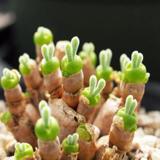
然后可能出现一个问题,为什么多肉才种两三天,多肉就化水、黑掉、异色。
因为今年的春天有点烦,以厦门为例,才4月,已经连续两天最高气温30℃了(去年的同期是20℃,上30℃是5月以后的事了),缓苗期直接露养,光照太强,很容易病菌侵入感染,再考虑到一部分人种植前可能也没修根晾根,出问题也就是概率事件。多肉是喜光照植物没错,但是缓苗期,只要不徒长,只要不褪色,真的是光照越少越好,一旦温度上了30℃,通风明亮无直射光处是多肉缓苗安身立命之本。
除了刚买回来的多肉种下要缓苗之外,原本在室内种植的,这段时间搬出来,也要注意缓苗,不能一下子就全日照,当下植株比较娇嫩,全日照,轻则晒伤,种则晒黑、化水、异色。
花友淡淡的烟味,原本种在室内,搬出去晒了两天的多肉


还有,盆土太潮湿,光照太强,温度太高,也会容易引起一些景天属的多肉掉叶子化水,尤其是园土、沙土这类保水性太强又不透气的,应注意控水通风。
刚买回来这种带土而且是园土的,有一个毛病,土很容易湿很久,高温下容易出事。

总的来说,最近温度一下子上30℃的地区,应多留意下自家的多肉,一些长势不佳的,如叶片长期干瘪,叶片消耗过快,有掉叶化水迹象的,可以适当遮阴,做下度夏准备了。
因为今年的春天有点烦,以厦门为例,才4月,已经连续两天最高气温30℃了(去年的同期是20℃,上30℃是5月以后的事了),缓苗期直接露养,光照太强,很容易病菌侵入感染,再考虑到一部分人种植前可能也没修根晾根,出问题也就是概率事件。多肉是喜光照植物没错,但是缓苗期,只要不徒长,只要不褪色,真的是光照越少越好,一旦温度上了30℃,通风明亮无直射光处是多肉缓苗安身立命之本。
除了刚买回来的多肉种下要缓苗之外,原本在室内种植的,这段时间搬出来,也要注意缓苗,不能一下子就全日照,当下植株比较娇嫩,全日照,轻则晒伤,种则晒黑、化水、异色。
花友淡淡的烟味,原本种在室内,搬出去晒了两天的多肉


还有,盆土太潮湿,光照太强,温度太高,也会容易引起一些景天属的多肉掉叶子化水,尤其是园土、沙土这类保水性太强又不透气的,应注意控水通风。
刚买回来这种带土而且是园土的,有一个毛病,土很容易湿很久,高温下容易出事。

总的来说,最近温度一下子上30℃的地区,应多留意下自家的多肉,一些长势不佳的,如叶片长期干瘪,叶片消耗过快,有掉叶化水迹象的,可以适当遮阴,做下度夏准备了。
3
3
文章
权问薇
2018年04月28日

剪1串珠子扔土里,呼呼长成绿帘子
成串的佛珠就像窗帘子似的,悬挂在家里真的好美啊,想让佛珠一盆变多盆,就得学花花这么做!

1、剪下佛珠串
剪下佛珠翠绿健康的枝条,一般5-7珠子为一串。一定要注意每段都要有根结才能成活,就是小凸起。

2、再剪掉2个珠子
再把每串佛珠一头的2个珠子剪掉,留出较长的茎部,可以深埋到土里。把枝条放到通风阴凉处,晾干伤口。
3、配土
土壤用珍珠岩或者河沙,可以提高透水透气性,防止腐烂。

4、枝条插入土中
把枝条插入土里,要用土埋的深一些,防止后期枝条变长变重,把佛珠连根拔起。最后浇1次透水,放到散射光下。等土干了就浇水,一般7-15天就会生根了。
5、这么养护,呼呼长成绿帘子
春天比较干燥,可以每天往珠子周围喷水,也可以每个月喷点稀释的磷酸二氢钾,让珠子长得更加圆润饱满。挂在客厅,亲戚朋友来了看到后肯定羡慕极了!
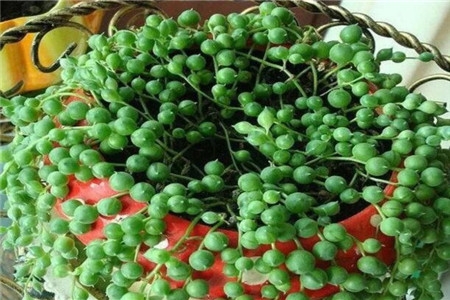
掰1片叶子扔土里,嗖嗖窜满盆
平时不小心碰掉了肉肉的叶子,花友们就会很心疼,其实完全没必要心疼哦,把1片叶子扔土里,就能呼呼生根窜新芽,想养100盆都没问题!来看看花花是咋做的!

1、挑选健康的叶子
选择健康饱满的叶子,尽量别选发黄、病虫害等不健康的叶子,不但成活率低,还会感染其他叶片哦。放到阴凉通风处晾干伤口。

2、配土
叶插的土壤可以用蛭石或者河沙等透气性比较好的土,避免烂根。然后用喷壶朝土壤表面喷洒,让土壤保持潮湿。
3、叶子斜插到土里
先找一个小木棍,在土里戳一个小坑,然后把晾干伤口的叶片斜着放入小坑里,轻轻用土掩埋,放到散射光下。

4、15天后生根
一般等15天后,叶片就生出大白根啦,要保持土壤潮湿,经常往土壤表面喷水。生根之后可以适当增加光照强度。
5、30天后,呼呼冒侧芽
等30天后,肉肉就会长出侧芽了,新芽越长越大,避免阳光直射,土干了再浇水。让老叶片自己慢慢枯萎脱落,不要用手摘掉,防止伤害新芽和根系。

剪个枝扔水里,呼呼冒出大白根
想让肉肉一盆变100盆,还有一个更简便的方法,那就是扔水里诱根,既卫生又高效,快来看看咋做的!
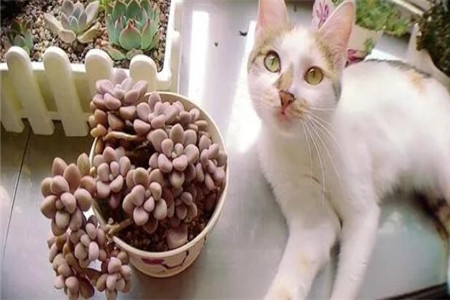
1、剪下健壮枝条
挑选肉肉健壮饱满的枝条,剪下来之后放到通风好的地方,先让伤口晾干。

2、浸泡在白糖水中,促进生根
先把白糖和热水按照1:10的比例融化,等白糖水彻底凉透之后,把肉肉枝条放到白糖水里,浸泡20分钟后拿出来用清水冲洗一下,再晾干伤口。
3、插清水里
找一个干净的瓶子,往里边倒入2/3的清水,然后把肉肉枝条放入水中。放到散射光、通风好的地方。

4、1-2周就生根啦
大概1-2周后,就会看到肉肉生出大白根啦。
5、移栽到土里
等根系长到2厘米的时候,先取出来稍微晾一下根部的水,然后就可以上盆啦!这种水培方法可以大大提高生根率哦。

肉肉扦插方法,你试过几种呀?
趁着春天赶紧扦插吧!错过得再等1年哦!如果觉得方法还不错,就分享给朋友们吧!
成串的佛珠就像窗帘子似的,悬挂在家里真的好美啊,想让佛珠一盆变多盆,就得学花花这么做!

1、剪下佛珠串
剪下佛珠翠绿健康的枝条,一般5-7珠子为一串。一定要注意每段都要有根结才能成活,就是小凸起。

2、再剪掉2个珠子
再把每串佛珠一头的2个珠子剪掉,留出较长的茎部,可以深埋到土里。把枝条放到通风阴凉处,晾干伤口。
3、配土
土壤用珍珠岩或者河沙,可以提高透水透气性,防止腐烂。

4、枝条插入土中
把枝条插入土里,要用土埋的深一些,防止后期枝条变长变重,把佛珠连根拔起。最后浇1次透水,放到散射光下。等土干了就浇水,一般7-15天就会生根了。
5、这么养护,呼呼长成绿帘子
春天比较干燥,可以每天往珠子周围喷水,也可以每个月喷点稀释的磷酸二氢钾,让珠子长得更加圆润饱满。挂在客厅,亲戚朋友来了看到后肯定羡慕极了!

掰1片叶子扔土里,嗖嗖窜满盆
平时不小心碰掉了肉肉的叶子,花友们就会很心疼,其实完全没必要心疼哦,把1片叶子扔土里,就能呼呼生根窜新芽,想养100盆都没问题!来看看花花是咋做的!

1、挑选健康的叶子
选择健康饱满的叶子,尽量别选发黄、病虫害等不健康的叶子,不但成活率低,还会感染其他叶片哦。放到阴凉通风处晾干伤口。

2、配土
叶插的土壤可以用蛭石或者河沙等透气性比较好的土,避免烂根。然后用喷壶朝土壤表面喷洒,让土壤保持潮湿。
3、叶子斜插到土里
先找一个小木棍,在土里戳一个小坑,然后把晾干伤口的叶片斜着放入小坑里,轻轻用土掩埋,放到散射光下。

4、15天后生根
一般等15天后,叶片就生出大白根啦,要保持土壤潮湿,经常往土壤表面喷水。生根之后可以适当增加光照强度。
5、30天后,呼呼冒侧芽
等30天后,肉肉就会长出侧芽了,新芽越长越大,避免阳光直射,土干了再浇水。让老叶片自己慢慢枯萎脱落,不要用手摘掉,防止伤害新芽和根系。

剪个枝扔水里,呼呼冒出大白根
想让肉肉一盆变100盆,还有一个更简便的方法,那就是扔水里诱根,既卫生又高效,快来看看咋做的!

1、剪下健壮枝条
挑选肉肉健壮饱满的枝条,剪下来之后放到通风好的地方,先让伤口晾干。

2、浸泡在白糖水中,促进生根
先把白糖和热水按照1:10的比例融化,等白糖水彻底凉透之后,把肉肉枝条放到白糖水里,浸泡20分钟后拿出来用清水冲洗一下,再晾干伤口。
3、插清水里
找一个干净的瓶子,往里边倒入2/3的清水,然后把肉肉枝条放入水中。放到散射光、通风好的地方。

4、1-2周就生根啦
大概1-2周后,就会看到肉肉生出大白根啦。
5、移栽到土里
等根系长到2厘米的时候,先取出来稍微晾一下根部的水,然后就可以上盆啦!这种水培方法可以大大提高生根率哦。

肉肉扦插方法,你试过几种呀?
趁着春天赶紧扦插吧!错过得再等1年哦!如果觉得方法还不错,就分享给朋友们吧!
0
1
文章
Miss Chen
2018年04月25日

Description: This perennial herbaceous plant consists of a low rosette of basal leaves up to 5" across, from which one or more flowering stalks develop. The blades of the basal leaves are up to 3½" and 2" across, although they are typically about one-half of this size during the blooming period. These leaf blades are ovate, oval, or cordate-oval in shape, while their margins are crenate. The upper surface of these leaf blades is medium green and glabrous to sparsely pubescent, while the lower surface is pale green and either glabrous, pubescent along the central vein, or pubescent generally. The petioles are less than one-third of the length of the leaf blades; they are light green to reddish green and glabrous to pubescent (hairs are especially likely to occur toward the bases of the petioles). The ascending pedicels of the flowers are 3-5" long, light green to reddish green, terete, and glabrous (less often pubescent). Toward the middle of each pedicel, there is a pair of tiny leafy bracts that are lanceolate in shape. The apices of the pedicels curve downward, where the flowers occur.
Each flower is about ½" across, consisting of 5 white spreading petals, 5 light green sepals, and the inconspicuous reproductive organs. The lowest petal of each flower has several purple veins and it is beardless (lacking a patch of hairs) at its base. Toward the back of the flower, this petal tapers into a short stout nectar-spur. The two lower lateral petals have either reduced purple veins or they are veinless; their bases are either beardless or slightly bearded. The upper lateral petals lack purple veins and they are always beardless. The sepals are lanceolate and glabrous; the basal lobes of the sepals are short and rounded. The blooming period of these flowers occurs from mid-spring to early summer, lasting about 3-4 weeks. In addition to the showy flowers that have been described, there are also inconspicuous cleistogamous flowers that are self-fertile; they are produced shortly afterwards. The fertilized showy flowers and cleistogamous flowers are replaced by green seed capsules that become up to ½" long at maturity; they are ovoid-oblongoid in shape and glabrous. At maturity, these capsules divide into 3 parts, flinging their seeds in the process. The small seeds are 1.0–1.5 mm. long and globoid to ovoid in shape. The root system consists of a slender crown with fibrous roots and stolon-like rhizomes; clonal offsets are produced from the rhizomes, causing small colonies of plants to develop.

Cultivation: The preference is partial sun, moist conditions, and sandy soil.
Range & Habitat: Primrose-leaved Violet occurs in only 3 counties of NE Illinois, where it is rare and native (see Distribution Map). It is state-listed as 'endangered.' Outside of Illinois, this violet occurs primarily in sandy areas along the Atlantic coastal plain and Gulf of Mexico region. There is also a variety of this violet that occurs in the Pacific northwest. Habitats include moist sand prairies, sandy shrub prairies, moist sandy savannas, openings in moist sandy woodlands, and sandy paths through wooded areas. Primrose-leaved Violet is found in high quality natural areas, especially where there have been wildfires that reduced overhead woody vegetation. It also adapts to grassy paths in these areas if they are not mowed too often or too low.

Faunal Associations: The flowers of Primrose-leaved Violet probably attract the same, or similar, insect pollinators as other violets with white flowers. Such insects include honeybees, bumblebees, long-horned bees (Synhalonia spp.), mason bees (Osmia spp.), an oligolectic Andrenid bee (Andrena violae), the Giant Bee Fly (Bombylius major), small- to medium-sized butterflies, and skippers (Robertson, 1929). Bees are the most important pollinators. Sometimes ants enter the flowers of violets to feed on nectar, but they are not effective pollinators. Other insects feed on the foliage and other parts of violets. These insect feeders include the caterpillars of several Fritillary butterflies (Boloria spp., Speyeria spp.), larvae of the Violet Sawfly (Ametastega pallipes), the Violet Aphid (Neotoxoptera violae), larvae of the Violet Fruit Midge (Dasineura semenivora) and Violet Gall Midge (Prodiplosis violicola), and a thrips (Odontothrips pictipennis); see Bouseman & Sternburg (2001), Smith (2006), Hottes & Frison (1931), Felt (1917), Aldrich & Osten-Sacken (1905), and Stannard (1968). The seeds of violets are eaten to some extent by such birds as the Ruffed Grouse, Wild Turkey, Bobwhite Quail, Mourning Dove, and Slate-colored Junco; the White-footed Mouse and Woodland Vole also eat the seeds. The Cottontail Rabbit and White-tailed Deer feed on the foliage of violets to a minor extent, as does the Eastern Chipmunk and Wood Turtle (Clemmys insculpta); see Martin et al. (1951/1961), Augustine (1997), Wrazen & Svendsen (1978), and Ernst et al. (1994).

Photographic Location: Grassy paths through moist sandy savannas and moist sandy woodlands at the Iroquois County Conservation Area in Illinois.
Comments: This is one of the smaller violets with dainty flowers and foliage. It remains inconspicuous, except when it blooms. Primrose-leaved Violet (Viola primulifolia) is probably a naturally occurring hybrid of two other native violets, Lance-leaved Violet (Viola lanceolata) and Small White Violet (Viola macloskeyi pallens). As a result, some authorities refer to Primrose-leaved Violet as a hybrid, or Viola × primulifolia. This violet can be distinguished from other violets (Viola spp.) by its white flowers and the shape of its leaves. These leaves are more broad than those of Lance-leaved Violet, but they are less orbicular in shape than those of Small White Violet. The Sand Violet (Viola fimbriatula) has leaves that are similar in shape to those of Primrose-leaved Violet, but the foliage of Sand Violet is usually more pubescent and its flowers are blue-violet. Across its range, the Primrose-leaved Violet is somewhat variable in the pubescence of its foliage. In the northern parts of its range (including Illinois), the foliage of this violet is mostly glabrous, but in the southern parts of its range (e.g., in SE United States), its foliage is more pubescent.
Each flower is about ½" across, consisting of 5 white spreading petals, 5 light green sepals, and the inconspicuous reproductive organs. The lowest petal of each flower has several purple veins and it is beardless (lacking a patch of hairs) at its base. Toward the back of the flower, this petal tapers into a short stout nectar-spur. The two lower lateral petals have either reduced purple veins or they are veinless; their bases are either beardless or slightly bearded. The upper lateral petals lack purple veins and they are always beardless. The sepals are lanceolate and glabrous; the basal lobes of the sepals are short and rounded. The blooming period of these flowers occurs from mid-spring to early summer, lasting about 3-4 weeks. In addition to the showy flowers that have been described, there are also inconspicuous cleistogamous flowers that are self-fertile; they are produced shortly afterwards. The fertilized showy flowers and cleistogamous flowers are replaced by green seed capsules that become up to ½" long at maturity; they are ovoid-oblongoid in shape and glabrous. At maturity, these capsules divide into 3 parts, flinging their seeds in the process. The small seeds are 1.0–1.5 mm. long and globoid to ovoid in shape. The root system consists of a slender crown with fibrous roots and stolon-like rhizomes; clonal offsets are produced from the rhizomes, causing small colonies of plants to develop.

Cultivation: The preference is partial sun, moist conditions, and sandy soil.
Range & Habitat: Primrose-leaved Violet occurs in only 3 counties of NE Illinois, where it is rare and native (see Distribution Map). It is state-listed as 'endangered.' Outside of Illinois, this violet occurs primarily in sandy areas along the Atlantic coastal plain and Gulf of Mexico region. There is also a variety of this violet that occurs in the Pacific northwest. Habitats include moist sand prairies, sandy shrub prairies, moist sandy savannas, openings in moist sandy woodlands, and sandy paths through wooded areas. Primrose-leaved Violet is found in high quality natural areas, especially where there have been wildfires that reduced overhead woody vegetation. It also adapts to grassy paths in these areas if they are not mowed too often or too low.

Faunal Associations: The flowers of Primrose-leaved Violet probably attract the same, or similar, insect pollinators as other violets with white flowers. Such insects include honeybees, bumblebees, long-horned bees (Synhalonia spp.), mason bees (Osmia spp.), an oligolectic Andrenid bee (Andrena violae), the Giant Bee Fly (Bombylius major), small- to medium-sized butterflies, and skippers (Robertson, 1929). Bees are the most important pollinators. Sometimes ants enter the flowers of violets to feed on nectar, but they are not effective pollinators. Other insects feed on the foliage and other parts of violets. These insect feeders include the caterpillars of several Fritillary butterflies (Boloria spp., Speyeria spp.), larvae of the Violet Sawfly (Ametastega pallipes), the Violet Aphid (Neotoxoptera violae), larvae of the Violet Fruit Midge (Dasineura semenivora) and Violet Gall Midge (Prodiplosis violicola), and a thrips (Odontothrips pictipennis); see Bouseman & Sternburg (2001), Smith (2006), Hottes & Frison (1931), Felt (1917), Aldrich & Osten-Sacken (1905), and Stannard (1968). The seeds of violets are eaten to some extent by such birds as the Ruffed Grouse, Wild Turkey, Bobwhite Quail, Mourning Dove, and Slate-colored Junco; the White-footed Mouse and Woodland Vole also eat the seeds. The Cottontail Rabbit and White-tailed Deer feed on the foliage of violets to a minor extent, as does the Eastern Chipmunk and Wood Turtle (Clemmys insculpta); see Martin et al. (1951/1961), Augustine (1997), Wrazen & Svendsen (1978), and Ernst et al. (1994).

Photographic Location: Grassy paths through moist sandy savannas and moist sandy woodlands at the Iroquois County Conservation Area in Illinois.
Comments: This is one of the smaller violets with dainty flowers and foliage. It remains inconspicuous, except when it blooms. Primrose-leaved Violet (Viola primulifolia) is probably a naturally occurring hybrid of two other native violets, Lance-leaved Violet (Viola lanceolata) and Small White Violet (Viola macloskeyi pallens). As a result, some authorities refer to Primrose-leaved Violet as a hybrid, or Viola × primulifolia. This violet can be distinguished from other violets (Viola spp.) by its white flowers and the shape of its leaves. These leaves are more broad than those of Lance-leaved Violet, but they are less orbicular in shape than those of Small White Violet. The Sand Violet (Viola fimbriatula) has leaves that are similar in shape to those of Primrose-leaved Violet, but the foliage of Sand Violet is usually more pubescent and its flowers are blue-violet. Across its range, the Primrose-leaved Violet is somewhat variable in the pubescence of its foliage. In the northern parts of its range (including Illinois), the foliage of this violet is mostly glabrous, but in the southern parts of its range (e.g., in SE United States), its foliage is more pubescent.
1
0
文章
Miss Chen
2018年04月25日

Description: This perennial plant consists of a rosette of basal leaves about 5" across. The blade of each basal leaf is about 2" long and ¾" across; it is oval to ovate-oblong, crenate and ciliate along the margins, and more or less hairy, especially along the lower surface. The bottom of each leaf blade has tiny basal lobes that are rounded or bluntly pointed, while the tip of the leaf blade is rather blunt and obtuse. The leaf blade may fold upward along its central vein. The stout petiole of each leaf is green to reddish brown and hairy; it is as long as the leaf blade or a little shorter. From the center of the rosette, there develops one or stalks of flowers up to 6" long. These stalks develop directly from the rootstock; they are reddish purple and either glabrous or hairy. Each of these stalks is naked, except for a pair of tiny leaf-like bracts near the middle. At the apex of each stalk, there is a single flower about ¾" across. It consists of 5 green sepals and 5 blue-violet petals consisting of 2 upper lateral petals, 2 lower lateral petals, and a bottom petal. The sepals are lanceolate and glabrous or hairy. The lower lateral petals have conspicuous white hairs near the throat of the flower. The bottom petal is white at the base and it has dark blue-violet lines that function as nectar guides for visiting insects.
The blooming period occurs from mid- to late spring and lasts about a month. There is no noticeable floral scent. Flowers that are successfully cross-pollinated will develop ovoid-oblongoid capsules that contain many seeds. Later, self-fertile cleistogamous flowers will develop from erect or ascending stalks; they lack petals and are inconspicuous. The cleistogamous flowers also produce seed capsules. These capsules divide into 3 parts at maturity, flinging the seeds. The seeds are small, globoid, and brown. The root system consists of stout scaly rhizomes with fibrous roots.
Cultivation: The preference is full sun to light shade, moist to slightly dry conditions, and sandy soil.

Range & Habitat: The native Sand Violet is occasional in sandy areas of central and northern Illinois, otherwise it is rare or absent (see Distribution Map). Habitats include sandy woodlands, thinly wooded slopes, sandy savannas, sand prairies, semi-shaded areas along sandy paths, and abandoned sandy fields. Usually, this species is found in mesic to slightly dry areas of these habitats. It benefits from occasional wildfires, as this reduces the competition from taller vegetation.
Faunal Associations: The flowers of violets (Viola spp.) are pollinated by bees, especially mason (Osmia spp.) and Andrenid bees. Butterflies and skippers may suck nectar from the flowers, but they are less effective at cross-pollination. The foliage of violets is eaten by the caterpillars of Fritillary butterflies and several species of moths (see Butterfly & Moth Table). The seeds are eaten to a limited extent by upland gamebirds, including the Mourning Dove, Ruffed Grouse, Bobwhite, and Wild Turkey. The Wild Turkey also digs up and eats the rhizomes. The White-Footed Mouse also eats the seeds of violets, while the White-Tailed Deer and Cottontail Rabbit browse on the foliage only very sparingly. Because the seeds have oily elaisomes (food appendages), they are distributed to some extent by ants and possibly other insects.

Photographic Location: Along a path through a sandy savanna that had been subjected to a recent wildfire in Kankakee County, Illinois.
Comments: The Sand Violet (Viola fimbriatula) is closely related to Viola sagitatta (Arrow-leaved Violet), and it is classified as a variety of the latter species, Viola sagitatta ovata, by some authorities. The Sand Violet is usually hairier and its basal leaves are more broad with blunt tips. The Arrow-leaved Violet has basal leaves that are more lanceolate with spreading basal lobes (i.e., they are hastate in shape). The Arrow-leaved Violet occurs throughout Illinois in both sandy and non-sandy habitats. Another species, Viola primulifolia (Primrose-leaved Violet), has basal leaves that are similar in shape to those of the Sand Violet, but its flowers are white. Sometimes this latter species is regarded as a hybrid.
The blooming period occurs from mid- to late spring and lasts about a month. There is no noticeable floral scent. Flowers that are successfully cross-pollinated will develop ovoid-oblongoid capsules that contain many seeds. Later, self-fertile cleistogamous flowers will develop from erect or ascending stalks; they lack petals and are inconspicuous. The cleistogamous flowers also produce seed capsules. These capsules divide into 3 parts at maturity, flinging the seeds. The seeds are small, globoid, and brown. The root system consists of stout scaly rhizomes with fibrous roots.
Cultivation: The preference is full sun to light shade, moist to slightly dry conditions, and sandy soil.

Range & Habitat: The native Sand Violet is occasional in sandy areas of central and northern Illinois, otherwise it is rare or absent (see Distribution Map). Habitats include sandy woodlands, thinly wooded slopes, sandy savannas, sand prairies, semi-shaded areas along sandy paths, and abandoned sandy fields. Usually, this species is found in mesic to slightly dry areas of these habitats. It benefits from occasional wildfires, as this reduces the competition from taller vegetation.
Faunal Associations: The flowers of violets (Viola spp.) are pollinated by bees, especially mason (Osmia spp.) and Andrenid bees. Butterflies and skippers may suck nectar from the flowers, but they are less effective at cross-pollination. The foliage of violets is eaten by the caterpillars of Fritillary butterflies and several species of moths (see Butterfly & Moth Table). The seeds are eaten to a limited extent by upland gamebirds, including the Mourning Dove, Ruffed Grouse, Bobwhite, and Wild Turkey. The Wild Turkey also digs up and eats the rhizomes. The White-Footed Mouse also eats the seeds of violets, while the White-Tailed Deer and Cottontail Rabbit browse on the foliage only very sparingly. Because the seeds have oily elaisomes (food appendages), they are distributed to some extent by ants and possibly other insects.

Photographic Location: Along a path through a sandy savanna that had been subjected to a recent wildfire in Kankakee County, Illinois.
Comments: The Sand Violet (Viola fimbriatula) is closely related to Viola sagitatta (Arrow-leaved Violet), and it is classified as a variety of the latter species, Viola sagitatta ovata, by some authorities. The Sand Violet is usually hairier and its basal leaves are more broad with blunt tips. The Arrow-leaved Violet has basal leaves that are more lanceolate with spreading basal lobes (i.e., they are hastate in shape). The Arrow-leaved Violet occurs throughout Illinois in both sandy and non-sandy habitats. Another species, Viola primulifolia (Primrose-leaved Violet), has basal leaves that are similar in shape to those of the Sand Violet, but its flowers are white. Sometimes this latter species is regarded as a hybrid.
0
0
文章
权问薇
2018年04月24日


1、土壤
选择适宜的盆土非常重要,它是一种喜酸性的植物,适宜的PH值在5至6之间,它非常怕碱性土,所以一定不能种植在碱性壤土中。花土的选择可用混有泥炭土、腐叶土、菜园土等的沙壤红土,忌用不含腐殖质的煤渣土等。

2、温度
适合它的生长温度是在16到18℃,总体来讲还是比较符合春天的平均温度的。但是若是过低或是被太阳直射,就会对它的生长造成一定伤害。所以如在初春,温度若是太低了,我们需要注意做好保暖措施。平时要将其放在通风好、阳光足的地方来养。
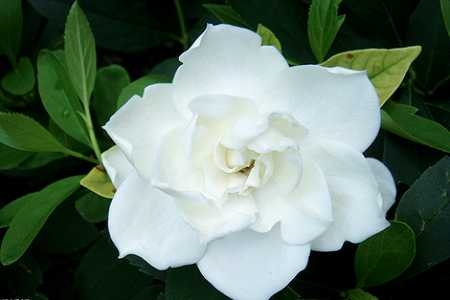
3、水分
对于它,水的控制要严。它较喜湿,但过度的潮湿会导致烂根,所以一定要合理浇水。浇水频率主要看壤土的干湿度,盆土一干就得浇水,在晚上可以用喷壶喷一下叶子,以增加湿度。
4、肥料
它是一种喜肥的植物,但又考虑到它须处于酸性花土中生长,所以每次施肥时要将少量的硫酸亚铁加到肥料中,发酵一会再施加肥料。到了春天的生长旺期,可以每隔半个月施一次肥,最好给肥料兑点水,避免浓度太高灼伤根部。

0
3
文章
Miss Chen
2018年04月23日

Description: This is a perennial plant that is about 2-3' tall. It has a stout central stem with four prominent ridges, while much smaller side stems may appear above the leaf axils in the upper half of the plant. The opposite leaves are up to 5" long and 2½" across. They are broadly ovate or lanceolate, coarsely serrated, and have deep venation. The lower leaves have short stout petioles, while the upper leaves are sessile. At the end of each stem is a terminal spike of numerous small flowers from 1-5" long. The flowers are white or light lavender with some purple near the base of the lower lip. Each flower is about 1/3" (8 mm.) long, with a greatly reduced upper lip and a long lower lip with a complicated structure. This lower lip functions as a landing pad for insect visitors, above which are two pairs of lateral petal-like extensions. The blooming period occurs from mid- to late summer, and lasts about 1½ months. There is no noticeable scent to the flowers. Each flower produces four round, coarsely pitted seeds with scattered white hairs. The root system is fibrous and rhizomatous. This plant spreads readily to form sizeable colonies.
Cultivation: The preference is full or partial sun, moist conditions, and a fertile loamy soil. American Germander can tolerate poorly drained conditions, but not much drought. It is occasionally bothered by foliar disease, particularly powdery mildew, when the plant is under stress, but not to the same degree as Wild Bergamot and other susceptible members of the Mint family. This plant can spread aggressively under moist conditions, and is rather weedy.
Range & Habitat: This is a common native plant that occurs in every county of Illinois (see Distribution Map). Habitats include moist black soil prairies, edges of bottomland forests, thickets, moist meadows along rivers, edges of marshes, and around seeps. American Germander can also be found in more developed areas, such as abandoned fields, partially shaded vacant lots, poorly drained waste areas, and along ditches near roads and railroads.

Faunal Associations: Long-tongued bees are the most important pollinators, including bumblebees, honeybees, Anthophorine bees, Cuckoo bees, Miner bees, and Leaf-Cutting bees. These bees collect pollen or suck nectar from the flowers. Other flower-visiting insects include Green Metallic bees, Bee flies, Thick-Headed flies, and various butterflies or skippers. Hummingbirds and Hummingbird moths are unusual visitors seeking nectar. Mammalian herbivores don't bother this plant because of the bitter leaves.
Photographic Location: The photographs were taken in a partially shaded waste area near a road in Urbana, Illinois.

Comments: This native plant is easy to confuse with other members of the Mint family, including the Eurasian species. It can be distinguished from all of them by the complicated structure of the long lower lip versus the greatly reduced size of the upper lip in the flowers. Some plants have a slight pubescence on the calyx and bracts, which are identified as var. boreale, while others lacking this pubescence are identified as var. virginicum. The former variety is absent from the southwestern counties of Illinois, while the latter variety occurs in every county. The unpleasant-tasting leaves were assumed to have medicinal value during pioneer days.
Cultivation: The preference is full or partial sun, moist conditions, and a fertile loamy soil. American Germander can tolerate poorly drained conditions, but not much drought. It is occasionally bothered by foliar disease, particularly powdery mildew, when the plant is under stress, but not to the same degree as Wild Bergamot and other susceptible members of the Mint family. This plant can spread aggressively under moist conditions, and is rather weedy.
Range & Habitat: This is a common native plant that occurs in every county of Illinois (see Distribution Map). Habitats include moist black soil prairies, edges of bottomland forests, thickets, moist meadows along rivers, edges of marshes, and around seeps. American Germander can also be found in more developed areas, such as abandoned fields, partially shaded vacant lots, poorly drained waste areas, and along ditches near roads and railroads.

Faunal Associations: Long-tongued bees are the most important pollinators, including bumblebees, honeybees, Anthophorine bees, Cuckoo bees, Miner bees, and Leaf-Cutting bees. These bees collect pollen or suck nectar from the flowers. Other flower-visiting insects include Green Metallic bees, Bee flies, Thick-Headed flies, and various butterflies or skippers. Hummingbirds and Hummingbird moths are unusual visitors seeking nectar. Mammalian herbivores don't bother this plant because of the bitter leaves.
Photographic Location: The photographs were taken in a partially shaded waste area near a road in Urbana, Illinois.

Comments: This native plant is easy to confuse with other members of the Mint family, including the Eurasian species. It can be distinguished from all of them by the complicated structure of the long lower lip versus the greatly reduced size of the upper lip in the flowers. Some plants have a slight pubescence on the calyx and bracts, which are identified as var. boreale, while others lacking this pubescence are identified as var. virginicum. The former variety is absent from the southwestern counties of Illinois, while the latter variety occurs in every county. The unpleasant-tasting leaves were assumed to have medicinal value during pioneer days.
0
0


